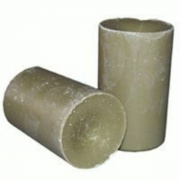Difference between revisions of "Bayberry wax"
m (Text replace - "== Authority ==" to "== Sources Checked for Data in Record ==") |
|||
| Line 39: | Line 39: | ||
| − | == | + | == Sources Checked for Data in Record == |
* G.S.Brady, ''Materials Handbook'', McGraw-Hill Book Co., New York, 1971 Comment: p. 844; melting point = 40-46C, specific gravity = 0.995, saponification value = 205-212, contains 58% myristic acid, 36% palmitic acid and 1.3% oleic acid. | * G.S.Brady, ''Materials Handbook'', McGraw-Hill Book Co., New York, 1971 Comment: p. 844; melting point = 40-46C, specific gravity = 0.995, saponification value = 205-212, contains 58% myristic acid, 36% palmitic acid and 1.3% oleic acid. | ||
Revision as of 13:02, 29 April 2016
Description
A greenish-white vegetable wax that covers the berries of small myrtle bushes, such as Myrica cerifera, native to America, Europe, and Africa. Bayberry wax, or myrtle wax, is collected by boiling the berries in water. It contains myristic acid (58%), Palmitic acid (36%) and Oleic acid (1.3%). Bayberry wax is used for soapmaking, candlemaking, and buffing metals. It has a balsam-like odor and has been used as a natural insect repellent.
Synonyms and Related Terms
"myrtle wax (Myrica cerifera; Morella cerifera); cera del árbol de la cera (Esp.); sweet gale (Myrica gale); candleberry wax (Myrica pensylvanica); capeberry wax (Myrica cordifolia); laurel wax; ocuba wax; bayberry tallow; vegetable tallow; waxmyrtle; wax-myrtle " ;
Other Properties
Iodine value=2.9-3.9, acid value=3.5, saponification value=205-217
| Melting Point | 40-49 |
|---|---|
| Density | 0.977-0.995 |
| Refractive Index | 1.436 |
Comparisons
Additional Images
Sources Checked for Data in Record
- G.S.Brady, Materials Handbook, McGraw-Hill Book Co., New York, 1971 Comment: p. 844; melting point = 40-46C, specific gravity = 0.995, saponification value = 205-212, contains 58% myristic acid, 36% palmitic acid and 1.3% oleic acid.
- Dictionary of Building Preservation, Ward Bucher, ed., John Wiley & Sons, Inc., New York City, 1996
- A History of Technology, Charles Singer, E.J. Holmyard, A.R. Hall (eds.), Clarendon Press, Oxford, Volume 1: From Early times to Fall of Ancient Empires, 1954
- Wikipedia, the free encyclopedia, at http://www.wikipedia.com Comment: http://en.wikipedia.org/wiki/Bayberry (Accessed Dec. 9, 2005) gives mp=45C, acdi number=15, saponification value=220, iodine number=6
- CRC Handbook of Chemistry and Physics, Robert Weast (ed.), CRC Press, Boca Raton, Florida, v. 61, 1980 Comment: melting point=46.7-48.8C, density=0.985, ref. index=1.436, iodine value=2.9-3.9, acid value=3.5, saponification value=205-217
- Van Nostrand's Scientific Encyclopedia, Douglas M. Considine (ed.), Van Nostrand Reinhold, New York, 1976
- The American Heritage Dictionary or Encarta, via Microsoft Bookshelf 98, Microsoft Corp., 1998


